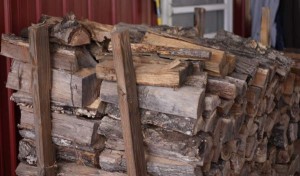Europe is struggling with record cold, snow, and ice that has killed more than 500 people. Here in the US, we’re on the flip side.
The winter of 2011-2012 has been unusually mild all over the US but is not yet one for the record books. The temperatures have been warm enough, however, to worry maple syrup producers, to increase the risk of late-season flu and allergies, to drive up tourist traffic in mountain resorts, and to lessen the cost of snow-plowing and pothole filling. There’s even a report that we’ll see more kittens in humane shelters. Yeah, weird.
 Here at Longleaf Breeze, we measure winters by the firewood we use. All our firewood is pretty much “perfect” for use in the stove, split and stacked for at least a year (usually two or more), and stored under cover in the barn since at least the preceding June. The only source of heat we have is our little wood stove, so on a cold winter day we’ll have two fires, one in the morning and another after sundown. We have never needed a fire to burn all day or all night to stay warm, and I don’t now expect we ever will, at least not here in the barn. Our home is just too tiny, too well insulated, and too well-designed ever to need supplemental heat even on the coldest day, and a fire in the evening keeps us warm through the night even after it goes out.
Here at Longleaf Breeze, we measure winters by the firewood we use. All our firewood is pretty much “perfect” for use in the stove, split and stacked for at least a year (usually two or more), and stored under cover in the barn since at least the preceding June. The only source of heat we have is our little wood stove, so on a cold winter day we’ll have two fires, one in the morning and another after sundown. We have never needed a fire to burn all day or all night to stay warm, and I don’t now expect we ever will, at least not here in the barn. Our home is just too tiny, too well insulated, and too well-designed ever to need supplemental heat even on the coldest day, and a fire in the evening keeps us warm through the night even after it goes out.
Our first winter here was 2009-2010. New to heating with wood, I went through a period of two weeks or so that I call My Season of Nocturnal Burning. Convinced that starting a fire was difficult and troublesome, I decided I needed to keep the fire going all night. I was getting up and feeding the fire in the middle of the night, we were opening the windows so we could stand to sleep in here, and it was a silly waste of firewood.
Once I figured out how easy it is to start a fire in our stove, we cut back on our firewood usage, but I was still figuring out how to heat gracefully with wood, and that first winter was a cold one, so we used more firewood that winter than we have any winter since, about five pallets. A pallet hold exactly 1/4 cord of wood, so that means we used 1 1/4 cords of firewood that first year. By the way, almost nobody actually has any idea of what a cord of firewood is, so they routinely allow firewood sellers to tell them they’re receiving “a cord” when they may be getting closer to 1/6 or 1/8 of a cord. A cord of firewood is a stack of firewood that’s 4 feet tall, 4 feet wide, and 8 feet long. That’s a LOT of firewood. The next time somebody tells you you’re looking at a cord of firewood, take a measuring tape to it. The next winter, 2010-2011, was a little more severe than the first, but I knew better how to use the stove, so we burned just four pallets and change, a little more than a cord.
Now jump to this winter, 2011-2012. Yesterday I placed the winter’s third pallet of firewood in position. The remainder of this winter is forecast to be milder than usual, but even if it were severe, I now know there’s no way we could burn through that third pallet. So that means we’re going to finish the winter of 2011-2012 burning less than three pallets of firewood, less than 3/4 of a cord for the entire season.
Add to this the very troublesome development that our chilling hours for fruit trees are way down and that the trees are budding too early, and it’s just weird. There’s no other way to describe it.